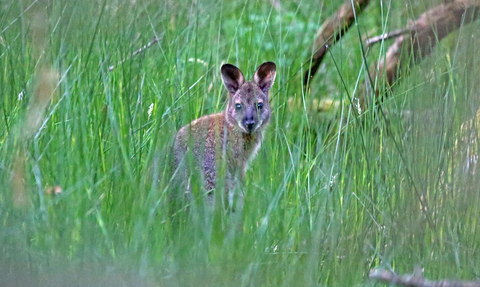
Graham Makepeace-Warne
State of Nature 2024 - Invasive Non-Native Species
Species that are not native to the Isle of Man can become detrimental to the local environment. They compete with native species for resources such as food and space, harming entire ecosystems and even causing potential extinction of other species. As well as invasive animal species such as Wallabies and R.A.T.s, MWT has recorded several marine invasive species, numerous plant species like Japanese Knotweed and Himalayan Balsam, as well as non-native diseases such as Ash die-back and Dutch Elm disease.
To categorise an invasive species, we must consider whether the introduction of a non-native species, either accidentally or intentionally, is having a detrimental effect on the ecosystem and its inhabitants. Our decision to take action is therefore dependent on the level of degradation, which can of course not be educated without the ‘before & after’ data evidencing the effect. Positive steps have been taken towards a biodiversity strategy and development of monitoring and action for marine non-native invasive species, but there is currently little coordination for action for the emerging terrestrial issues.
| Species | Native/Non-native | Evidence or harm | Route to control Priority for action |
|---|---|---|---|
| Wallaby | Non-native | Growing | To be considered (TBC) |
| European Gorse | Non-native | Clear | Yes, long term High |
| R.A.T. | Non-native | Clear | Yes, expensive & long term High, minus cost / benefit |
| Japanese Knotweed | Non-native | Clear | Yes, technical & three years Medium |
| Himalayan balsam | Non-native | Clear |
Positives for bees Yes, multiple years Medium |
| Bracken | Native | Clear | Unclear Localised |
| Rabbit | Non-native | Clear | Clear No action |
| Goat | Non-native | Clear | Clear Low |
| Skunk Cabbage | Non-native | Clear | Clear High |
| Canada Goose | Non-native | Clear | Unclear No action |
| Montbretia | Non-native | Clear | Clear Low to medium |
| Pacific Oyster | Non-native | Clear | Requires annual removal |
| Darwin’s barnacle | Non-native | Clear | Unclear TBC |
There are considerable resource implications for taking action, including funding, staff time, legislative or enforcement time, project coordination and expertise, and large-scale partnership motivation. Many species have clear examples and best practice that can easily be applied to control invasives. Control is required if we are to protect our native ecosystems and wildlife. Following the example of the upcoming marine biosecurity plan would be a great first step in the right direction.
